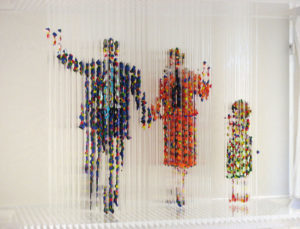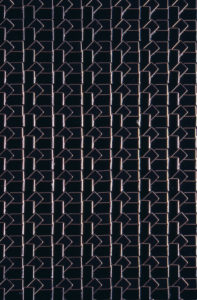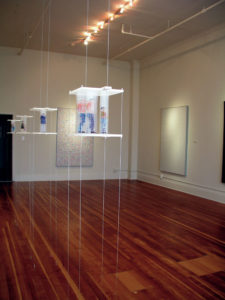
With the rise of digital technologies, the temptation has grown nearly irresistible to declare the art of painting dead once and for all. Even photography—whose mechanical processes have certainly posed their challenges to and transformed the work of painters—still entails the physical interplay of light and film that digital media supersede with their translation of all experience into the ones and zeros of “virtual reality.” While resisting the opposite and equally strong temptation to cling defensively to conventional notions of representation, Chris Dorosz challenges this all-too-facile cliché of post-modernity by exploring the material, analog properties of digital culture with paint.
For Dorosz, paint presents the obstinate persistence of physical reality in an age striving towards the ether of digital abstraction; and, in this show, he explored this intersection between the material and virtual in culture with careful attention to formal painting processes.

One series of paintings were constructed firstly of staples meticulously woven together in repeated, almost mechanical patterns, and subsequently filled in with paint. By weaving the staples—which conventionally function in painting technique only to hold canvas onto stretchers—into patterns in which one staple necessarily closes in on another in order to contain the paint, Dorosz established a parallel between the units created by the staples and the pixelation of digital screens. The paintings oscillated between representation and abstraction as figures dissolved into the digital units defined by the staples and the patterns they created on the paintings’ surfaces, while the play of light and color in their more abstract forms seemed at times to represent the empty surface of computer and television screens, as objects of enjoyment in themselves.

For a second series of works, Dorosz suspended what at first appeared to be small figurative sculptures between plates of Plexiglas. Upon further examination, however, they too revealed themselves to be paintings. Responding to the techniques of digital animation, Dorosz constructed fields of transparent rods, upon which he painted figures, not simply by creating the illusion of depth, but by actually reconstructing the depth-of-field. He painted the figures from all sides, so that they stood suspended in the room, somewhere between the concrete reality of sculptural objects and the spectral illusion of holograms. Their bodies could be seen both as a crudely physical aggregate of drops of paint—whose material concreteness appeared all the more vivid against the cold surface of the Plexiglas rods—and as fantastical objects, with profoundly personal and sentimental qualities.